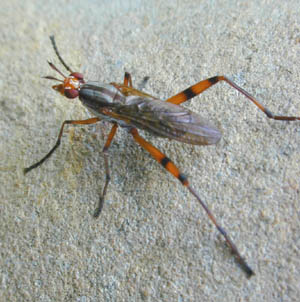
The Acalyptratae or Acalyptrata are a subsection of the Schizophora, which are a section of the order Diptera, the "true flies". In various contexts the Acalyptratae also are referred to informally as the acalyptrate muscoids, or acalyptrates, as opposed to the Calyptratae. All forms of the name refer to the lack of calypters in the members of this subsection of flies. An alternative name, Acalypterae is current, though in minority usage. It was first used by Pierre-Justin-Marie Macquart in 1835 for a section of his tribe Muscides; he used it to refer to all acalyptrates plus scathophagids and phorids, but excluding Conopidae.

Chrysopilus is common, worldwide genus of predatory snipe flies. There are approximately 300 species in the genus, including fossil members that are sometimes found in amber.

The Apioceridae, or flower-loving flies, are a small family of flies, all in the single genus Apiocera. They occur mostly in dry, sandy habitats in the deserts of North America, South America, and Australia. Other genera formerly placed in Apioceridae are now in Mydidae.

The Pyrgotidae are an unusual family of flies (Diptera), one of only two families of Cyclorrhapha that lack ocelli. Most species are "picture-winged", as is typical among the Tephritoidea, but unlike other tephritoids, they are endoparasitoids; the females pursue scarab beetles in flight, laying an egg on the beetle's back under the elytra where the beetle cannot reach it. The egg hatches and the fly larva enters the body cavity of the beetle, feeding and eventually killing the host before pupating. In the United States, some species of Pyrgota and Sphecomyiella can be quite common in areas where their host beetles are abundant. Like their host beetles, these flies are primarily nocturnal, and are often attracted to artificial lights.
Halydaia is a genus of flies in the family Tachinidae.
Paratropeza is a genus of flies in the family Tachinidae.
Prodiaphania is a genus of flies in the family Tachinidae.
Rutilotrixa is a genus of parasitic flies in the family Tachinidae.

Paramixogaster is a genus of hoverflies, with fewer than 30 known species. Paramixogaster has an appendix on vein R4+5 that is absent in Mixogaster.
Spaniopsis is a genus of snipe flies of the family Rhagionidae. They are very stout bodied flies from 3 to 6 mm, with generally grey or dark grey thorax, and are only known from Australia.
Austroleptis is a genus of snipe flies, and the sole genus in the family Austroleptidae; until 2010, it was placed in the family Rhagionidae. They are small to moderately sized flies of around 3 to 7.7 mm.
Atherimorpha is a genus of snipe fly of the family Rhagionidae.

Root-gall nematodes are plant-parasitic nematodes from the genus Subanguina that affect grasses, including cereals, and some other plants, such as mugwort. They are distinct from the Root-knot nematodes which are from the genus Meloidogyne. So far around twenty-five separate species of Subanguina have been identified, although the most well-known and type species is Subanguina radicicola.

Sergey Jacques Paramonov was a Soviet and Australian entomologist, specializing on flies (Diptera), of which described about 700 species and subspecies. Paramonov published over 185 scientific articles, some of which were published posthumously.

Ogcodes is a cosmopolitan genus of small-headed flies in the family Acroceridae. About 90 species have been described for the genus. It is the most common and speciose genus in its family. These flies are endoparasitoids of ground-dwelling entelegyne spiders.

Anastoechus is a genus of bee flies. There are at least 90 described species in Anastoechus.

Orthogonis is a genus of robber flies. There are about 14 described species in Orthogonis.

Pogonortalis is a genus of signal flies in the family Platystomatidae. There are about seven described species in Pogonortalis.

Amphibolia is a genus of bristle flies in the family Tachinidae.
Dasyomma is a genus of flies in the family Athericidae.












